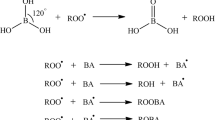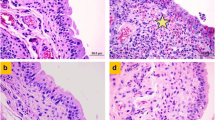Abstract
The aim of the present study was to evaluate the protective effects of the NF-кB inhibition with pyrrolidine-dithiocarbamate (PDTC) in ischemia–reperfusion (I/R) injury in the rat bladder. Twenty-four Sprague-Dawley male rats were divided into three groups. Group I; (n = 8) control, group II; (n = 8) I/R group; group III (n = 8) I/R and PDTC treatment. Superoxide dismutase (SOD), catalase (CAT), and gluatathione-S-transferase (GST) enzymes was studied in bladder tissue. Lipid peroxidation (as TBARS) levels in tissue homogenate were measured with thiobarbituric acid reaction. All the slides were stained with NF-кB, p53 and HSP60 immunohistochemistry for detection genome destruction and tissue stress, respectively. Our results show that the mean TBARS levels were significantly higher in group II (p < 0.05). The TBARS levels were significantly decreased in group III compared with the group II (p < 0.05). CAT, SOD and GST activities were decreased in group II, but these enzymes levels were significantly increased in group III according to the group II (p < 0.05). Under microscopic evaluation NF-кB expression increased significantly in group II compared to the group I (p < 0.05) and then decreased in group III (p < 0.05). HSP60 and p53 expression in group II was increased significantly compared with group I. Under microscopic evaluation we detected that HSP60 and p53 expression was increased significantly in group II compared with group I. In group III PDTC administration was decreased the HSP60 and p53 expression, this difference was statistically significant (p < 0.05). The results of the present study have demonstrated that NF-кB inhibition with PDTC protects and provides beneficial effects on ischemia/reperfusion stress related bladder tissue destruction.



Similar content being viewed by others
Abbreviations
- I/R:
-
Ischemia/reperfusion
- PDTC:
-
Pyrrolidine dithiocarbamate
- NF-кB:
-
Nuclear factor-кB
- HO-1:
-
Heme oxygenase-1
- GST:
-
Glutathione-S-transferase
- SOD:
-
Superoxide dismutase
- CAT:
-
Catalase
- TBARS:
-
Thiobarbituric acid reactive substance
- H&E:
-
Hematoxylin eosin
- HSP:
-
Heat shock protein
- ROS:
-
Reactive oxygen species
- MDA:
-
Malondialdehyde
- LPO:
-
Lipid peroxidation
References
Steers WD (1992) Physiology of the urinary bladder. In: Walsh PC, Retik AB, Stamey TA, Vaughan ED (eds) Campbell’s urology. WB Saunders, Philedelphia, pp 142–176
Erdem E, Leggett R, Dicks B, Kogan BA, Levin RM (2005) Effect of bladder ischaemia/reperfusion on superoxide dismutase activity and contraction. BJU Int 96:169–174
Levin R, Chichester P, Levin S, Buttyan R (2004) Role of angiogenesis in bladder response to partial outlet obstruction. Scand J Urol Nephrol Suppl 215:37–47
Greenland JE, Brading AF (1996) Urinary bladder blood flow changes during the micturition cycle in a conscious pig model. J Urol 156:1858–1861
Lin AT, Chen MT, Yang CH, Chang LS (1995) Blood flow of the urinary bladder: effects of outlet obstruction and correlation with bioenergetic metabolism. Neurourol Urodyn 14:285–292
Levin RM, Levin SS, Zhao Y, Buttyan R (1997) Cellular and molecular aspects of bladder hypertrophy. Eur Urol 32(Suppl 1):15–21
Orrenius S, Nobel CS, van den Dobbelsteen DJ, Burkitt MJ, Slater AF (1996) Dithiocarbamates and the redox regulation of cell death. Biochem Soc Trans 24:1032–1038
Teke Z, Kabay B, Aytekin FO et al (2007) Pyrrolidine dithiocarbamate prevents 60 minutes of warm mesenteric ischemia/reperfusion injury in rats. Am J Surg 194:255–262
Schreck R, Meier B, Männel DN, Dröge W, Baeuerle PA (1992) Dithiocarbamates as potent inhibitors of nuclear factor kappa B activation in intact cells. J Exp Med 175:1181–1194
Németh ZH, Deitch EA, Szabó C, Haskó G (2003) Pyrrolidine dithiocarbamate inhibits NF-kappaB activation and IL-8 production in intestinal epithelial cells. Immunol Lett 85:41–46
Willis D, Moore AR, Frederick R, Willoughby DA (1996) Heme oxygenase: a novel target for the modulation of the inflammatory response. Nat Med 2:87–90
Lee CH, Kim SH, Lee SM (2008) Effect of pyrrolidine dithiocarbamate on hepatic vascular stress gene expression during ischemia and reperfusion. Eur J Pharmacol 595:100–1007
Lowry O, Rosenbraugh N, Farr L, Randall R (1951) Protein measurement with folin phenol reagent. J Biol Chem 182:265–275
Van Ye TM, Roza AM, Pieper GM, Henderson J Jr, Johnson JP, Adams MB (1993) Inhibition of intestinal lipid peroxidation does not minimize morphological damage. J Surg Res 55:553–558
Durak I, Canbolat O, Kavutcu M, Öztürk HS, Yurtarslanı Z (1996) Activities of total, cytoplasmic and mitochondrial superoxide dismutase enzymes in sera and pleural fluids from patient with lung cancer. J Clin Lab Anal 10:17–20
Aebi H (1974) Catalase. In: Bergmeyer HU (ed) Methods of enzymatic analysis. Academic Press, New York, pp 673–677
Habig WH, Pabst MJ, Jakoby WB (1974) Glutathione S-transferases. The first enzymatic step in mercapturic acid formation. J Biol Chem 249:7130–7139
Matsumoto S, Hanai T, Yoshioka N et al (2005) Edaravone protects against ischemia/reperfusion-induced functional and biochemical changes in rat urinary bladder. Urology 66:892–896
Hayes JD, Flanagan JU, Jowsey IR (2005) Glutathione transferases. Annu Rev Pharmacol Toxicol 45:51–88
Röth E, Marczin N, Balatonyi B et al (2011) Effect of a glutathione S-transferase inhibitor on oxidative stress and ischemia-reperfusion-induced apoptotic signalling of cultured cardiomyocytes. Exp Clin Cardiol 16:92–96
Nazam Ansari M, Bhandari U, Islam F, Tripathi CD (2008) Evaluation of antioxidant and neuroprotective effect of ethanolic extract of Embelia ribes Burm in focal cerebral ischemia/reperfusion-induced oxidative stress in rats. Fundam Clin Pharmacol 22:305–314
Dib M, Garrel C, Favier A, Robin V, Desnuelle C (2002) Can malondialdehyde be used as a biological marker of progression in neurodegenerative disease? J Neurol 249:367–374
Fujihara CK, Antunes GR, Mattar AL, Malheiros DM, Vieira JM Jr, Zatz R (2007) Chronic inhibition of nuclear factor-kappaB attenuates renal injury in the 5/6 renal ablation model. Am J Physiol Renal Physiol 292:92–99
Chatterjee PK, di Villa Bianca RD, Sivarajah A, McDonald MC, Cuzzocrea S, Thiemermann C (2003) Pyrrolidine dithiocarbamate reduces renal dysfunction and injury caused by ischemia/reperfusion of the rat kidney. Eur J Pharmacol 482:271–280
Ebenezer PJ, Mariappan N, Elks CM et al (2009) Effects of pyrrolidine dithiocarbamate on high-fat diet-induced metabolic and renal alterations in rats. Life Sci 85:357–364
Hanawalt PC (2001) Controlling the efficiency of excision repair. Mutat Res 485:3–13
Smith ML, Seo YR (2002) p53 regulation of DNA excision repair pathways. Mutagenesis 17:149–156
Vargas-Parada L, Solís CF, Laclette JP (2001) Heat shock and stress response of Taenia solium and T. crassiceps (Cestoda). Parasitology 122:583–588
Calabrese V, Mancuso C, Ravagna A et al (2007) In vivo induction of heat shock proteins in the substantia nigra following L-DOPA administration is associated with increased activity of mitochondrial complex I and nitrosative stress in rats: regulation by glutathione redox state. J Neurochem 101:709–717
Rossi MR, Somji S, Garrett SH, Sens MA, Nath J, Sens DA (2002) Expression of hsp 27, hsp 60, hsc 70, and hsp 70 stress response genes in cultured human urothelial cells (UROtsa) exposed to lethal and sublethal concentrations of sodium arsenite. Environ Health Perspect 110:1225–1232
Conflict of interest
None.
Author information
Authors and Affiliations
Corresponding author
Rights and permissions
About this article
Cite this article
Yucel, M., Kucuk, A., Bayraktar, A.C. et al. Protective effects of the nuclear factor kappa B inhibitor pyrrolidine dithiocarbamate in bladder ischemia–reperfusion injury in rats. Mol Biol Rep 40, 5733–5740 (2013). https://doi.org/10.1007/s11033-013-2676-2
Received:
Accepted:
Published:
Issue Date:
DOI: https://doi.org/10.1007/s11033-013-2676-2




